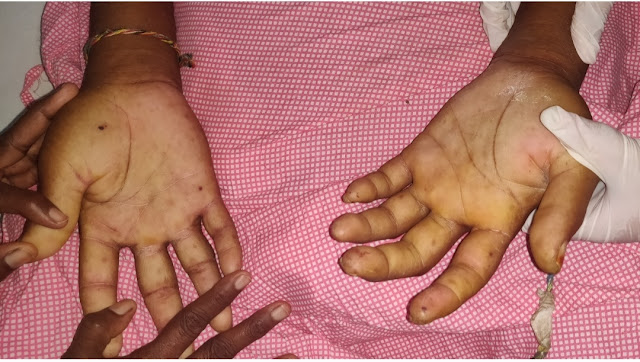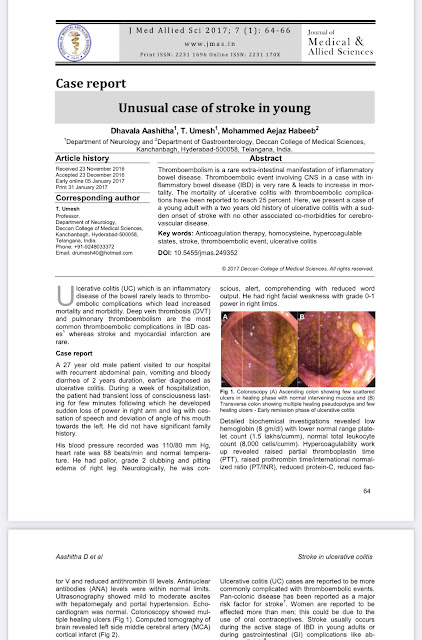55 year old man with Altered Sensorium, Heart Failure and Renal Failure
Bilateral lower limb edema since 6 months
Reduced urine output since 1 week
Dyspnea since 2 days
He works as tractor driver in a local village nearby. He got married 30 years back. His wife works as a daily wage labourer. He has two children, his son works as a tractor driver, he also sometimes helps his mother with her work and his daughter is married. According to his wife, they earn enough to provide the family's daily needs.
He regularly consumes alcohol and also is a tobacco chewer since the past 20 years. According to his son, he consumes around 90ml of whiskey twice a week along with occasional tordy consumption.
Since the past 2 years he apparently has been experiencing bilateral knee joint pain for which he has been consuming NSAIDs regularly.
6 months back, they first noticed him have bilateral lower limbs swelling upto his ankles which eventually resolved on its own. He however kept developing lower limb edema often which would always resolve on its own.
1 year back he underwent left eye cataract surgery at our hospital.
3 years back, the patient and his son suspected him to have diabetes as they noticed that it always took a while for his wounds to heal. His son took him to a local hospital where in he was diagnosed to have diabetes mellitus and was started on OHA's.
6 months back he experienced giddness and on taking him to a local hospital he was also diagnosed with hypertension and was started on an antihypertensive medication. And his diabetic medication dose was reduced.
Around 6th of February, last month he complained of reduce urine output. Around 13th of February, a week later, his family along with him decided to attend their relatives wedding. They left for the wedding and he was supposed to join them there for lunch but they noticed it was taking him a while to join them. On coming back home they found his dressed, sitting on a chair, dyspneic and profusely sweating. They immediately rushed him to a local hospital where they diagnosed him to have renal failure, his serum creatinine was found to be 9 mg/dl along with anemia of 5.8 mg/dl and was referred to a our center for further management.
On presentation to our hospital last month, the past was diagnosed to have Lateral wall STEMI, acute LVF and CKD. He was initiated on hemodialysis. He received 5 sessions of hemodialysis last month.
His ecg on first day of admission
His ecg on second day of admission
His chest xray showing straightening of left heart border, kerley B lines, cardiomegaly, batwing appearance.
He has been receiving regular hemodialysis at our hospital since then
After receiving hemodialysis on 9/03 the patient started to complain of chills and 1 day later he started experiencing fever. He also became drowsy on the 12th, though arousable and responding to commands. 2 days later he went into complete altered sensorium.
His son says that his sensorium has been fluctuating over the past few days, he sometimes makes eye contact and makes vocal sounds when he looks at him and sometimes he doesn't respond even on calling him repeatedly.
He attributes the events to the dialysis session which was on the 9th.
On Examination:
His BP - 100/60mmhg on 4ml/hour Norad infusion ( 4ml in 46ml of Normal Saline)
His PR - 120bpm
His RR - 28 cpm
Temp - 98 F
Spo2 - 98% on Room Air
Grbs - 147 mg/dl
Pallor +
Bilateral lower limb edema + extending upto his knees +
On General Examination:
Head:
Sparse Hair
Hypopigmented lesions noted on his Left elbow.
Also present on his chest according to his wife but couldn't appreciate it.
Petechiae present on bilateral palms +
Noticed this lesion on his Left Thigh - when enquired about it, he wife told us that he had a ?bleb there around 15 years ago which burst on its own
Petechia + on bilateral soles
Petechia + in bilateral soles
Ecchymosis with bullae +
With discharge oozing out
Videos showing his tachypnea, chest rise and fall
Meningeal Signs:
Kernig's sign +
Reflexes:
Cvs - Apex beat couldn't be localized
S1, S2 +
Lungs - Bilateral Inspiratory Crepts + in IAA, ISA
First Admission Timeline:
Post Readmission Timeline Events:
His ECGs:
17/3
18/3
20/3
22/3
2DECHO
Blood Agar showing golden yellow colonies from the central pus cultured
Problem Representation:
1. Anemia secondary to ?chronic disease
2. Renal Failure - ? Diabetes Nephropathy with other multiple risk factors playing a role, Hypertension, NSAIDs regular intake
3. Altered Sensorium -
? Secondary to Meningitis
? Uremic Encephalopathy
? Sepsis/ Septic Emboli
Source of Emboli - ? Cardioembolic
? Atrial Fibrillation
? Infective Endocarditis
4. Fever -
Secondary to UTI ( MRSA isolated from blood and urine cultures)
- ? Central line induced, post dialysis new onset infection
5. Hypotension -
Secondary to sepsis
6. Atrial Fibrillation -
Secondary to ? Recurrent Hyperkalemia
? Sepsis
? Ischaemic Heart Disease
7. Recurrent Hyperkalemia -
Secondary to ? Sepsis
? Ischaemic Heart Disease
8. Ischaemic Heart Disease- Post Lateral Wall Myocardial Infarction
9. New onset cutaneous lesions -
? Ecthyema Gangenosum secondary to MRSA
?Janeway lesions
? Vasculitis
10. Hypertensive since 6 months
11. Type 2 Diabetes Mellitus since 3 years
Altered Sensorium:
His CSF Analysis is in favour of pyogenic meningitis
? Secondary to MRSA
The other causes pathogenesis are discussed below:
Uremic Encephalopathy:
Plan of Action:
Continue Hemodialysis and Antibiotics until sepsis resolves
Staphylococcus Aureus:
In a national survey in the United States conducted in 2000–2001, Staphylococcus aureus infections were reported as a discharge diagnosis in 0.8% of all inpatients, and were associated with a five-fold increased risk of in-hospital mortality
Infective endocarditis by Staph Aureus in dialysis patients
'Twenty-eight patients were identified as having developed IE.
Staphylococcus aureus [including methicillin resistant Staphylococcus aureus (MRSA)] was present in 63.3%. The mitral valve was affected in 41.4% of patients, aortic valve in 37.9% of patients, and both valves were affected in 17.2% of patients.'
Next plan of action:
Repeat 2decho to look for any new regurgitation or vegetations
Transesophageal 2decho
Blood cultures to be sent:
1. Typical microorganism for IE from 2 separate blood cultures (as in our case)
2.In case of persistently positive blood culture:
3 blood cultures sent 1 hour apart or 2 blood cultures sent 12 hours apart
Plan on adding Vancomycin
Erythema Gangenosum and Staphylococcus Aurues:
Effect of Vancomycin or Daptomycin With vs Without an Antistaphylococcal β-Lactam on Mortality, Bacteremia, Relapse, or Treatment Failure in Patients With MRSA Bacteremia
Open-label, randomized clinical trial
P - 352 participants were included in this study
I - 174 patients on intravenous vancomycin or daptomycin) plus an antistaphylococcal β-lactam (intravenous flucloxacillin, cloxacillin, or cefazolin)
C - 178 patients on standard therapy alone
Total duration of therapy was determined by treating clinicians and the β-lactam was administered for 7 days.
O - For the combination therapy vs standard therapy groups, all-cause 90-day mortality occurred in 35 (21%) vs 28 (16%)
Persistent bacteremia at day 5 was observed in 19 of 166 (11%) vs 35 of 172 (20%)
AKI occurred in 34 of 145 (23%) vs 9 of 145 (6%)
Among patients with MRSA bacteremia, addition of an antistaphylococcal β-lactam to standard antibiotic therapy with vancomycin or daptomycin did not result in significant improvement in the primary composite end point of mortality, persistent bacteremia, relapse, or treatment failure
https://jamanetwork.com/journals/jama/fullarticle/2760737






























Comments
Post a Comment